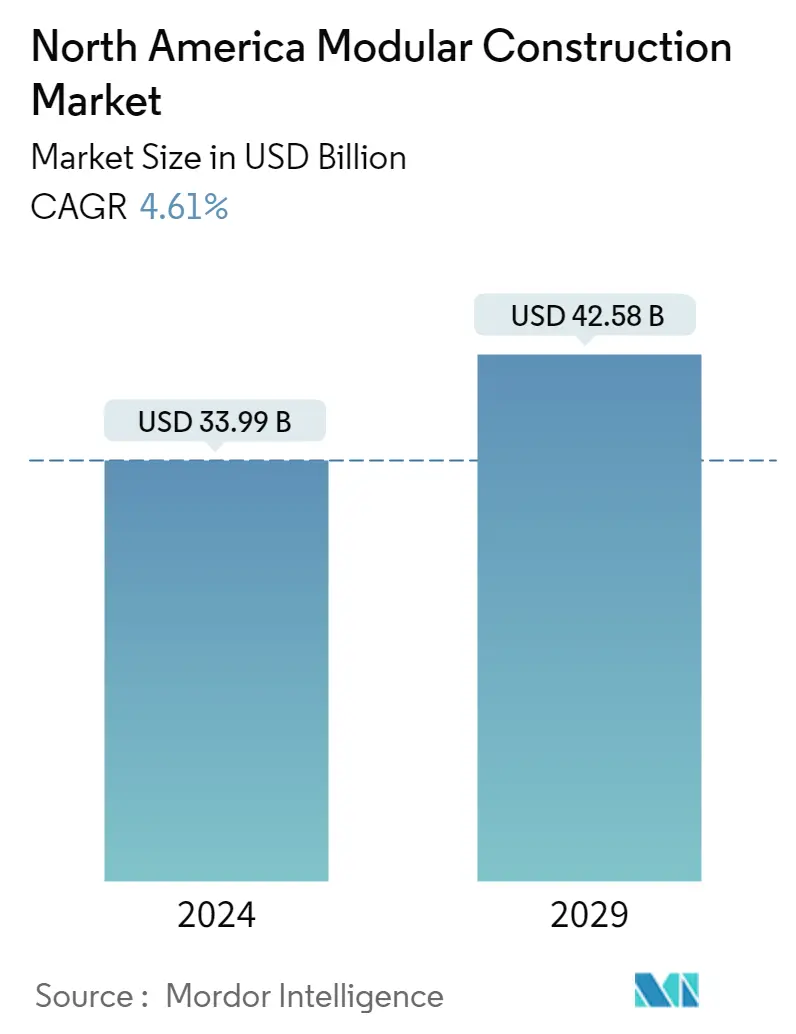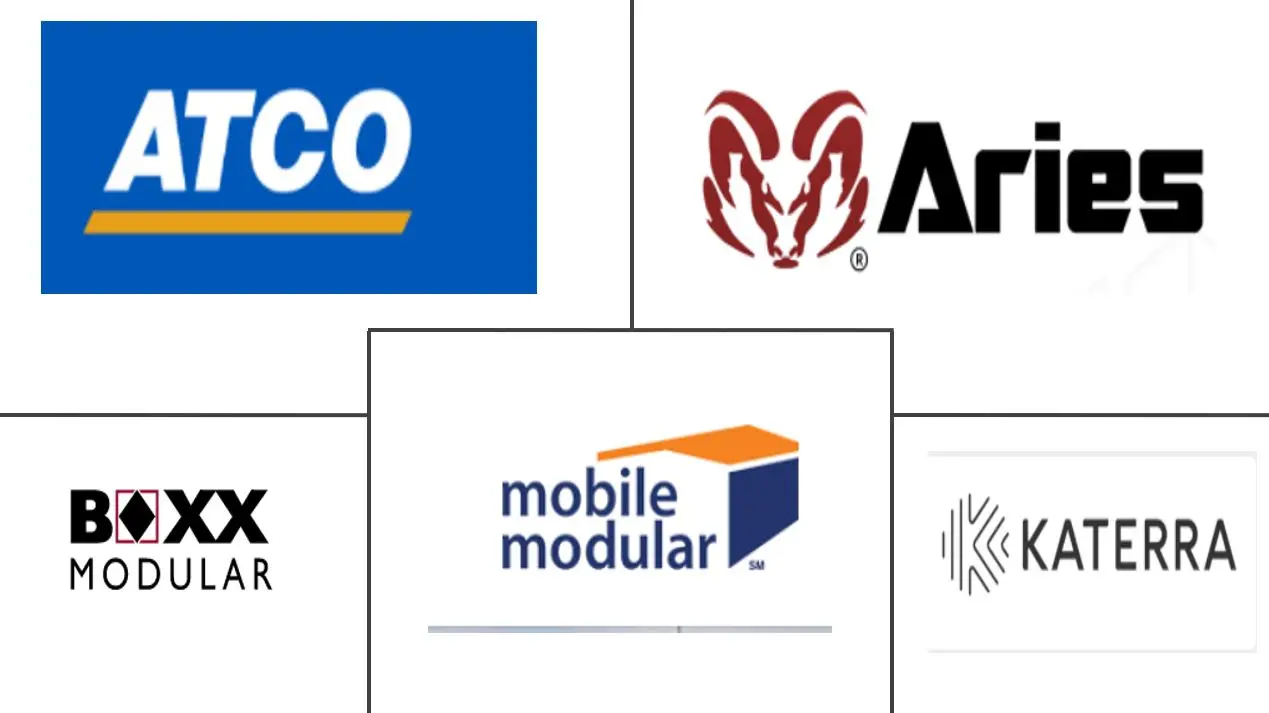Market Size of North America Modular Construction Industry

| Study Period | 2019 - 2029 |
| Base Year For Estimation | 2023 |
| Market Size (2024) | USD 33.99 Billion |
| Market Size (2029) | USD 42.58 Billion |
| CAGR (2024 - 2029) | 4.61 % |
| Market Concentration | Medium |
Major Players
*Disclaimer: Major Players sorted in no particular order |
North America Modular Construction Market Analysis
The North America Modular Construction Market size is estimated at USD 33.99 billion in 2024, and is expected to reach USD 42.58 billion by 2029, growing at a CAGR of 4.61% during the forecast period (2024-2029).
The COVID-19 pandemic had a negative impact on the market in 2020. In the event of a pandemic, construction operations were temporarily halted during the lockdown, resulting in a reduction in modular construction work in various construction segments such as educational, residential, and airports, negatively impacting demand for the modular market.
The North American modular industry is currently made up of over 250 regional manufacturers building everything from construction site offices to single-family homes and hotels. The industry is regulated primarily at the state level through administrative agencies that implement and enforce the rules for building in that state. However, only 35 states (and one Canadian province) have such a program, meaning the remaining jurisdictions rely on local code officials to determine compliance and safety. Additionally, the programs lack a degree of uniformity in requirements and even terminology. For example, the program in Massachusetts is referred to as the 'manufactured buildings program,' while in other states, the industry is referred to as 'industrialized buildings,' or 'factory-built housing.'
The modular industry manufactured and labelled 2,041 multifamily units in 2019 or about 7.2% of total industry output. This figure is down slightly from 2018 indicating a shift of production into other markets such as hospitality. . Five states account for the majority of multifamily modular projects: California, Massachusetts, New York, New Jersey, and Pennsylvania, with modular projects reported in nine other states. Many hospitals and healthcare facility contractors are turning to modular, primarily for building components such as bathroom pods and headwalls. However, entire hospitals have been constructed utilizing modular construction techniques. For educational units, California, Georgia, New York, North Carolina, Texas, and South Carolina were the top states in terms of utilizing modular construction in 2019, accounting for 45% of total production. Historically, one of the key markets for the modular industry in Canada has been the industrial workforce housing sector. The modular industry provided temporary workforce housing solutions in remote regions where the energy sector was active. With the decline in oil prices in recent years, the industry has diversified into some of the above-mentioned markets more aggressively.
North America Modular Construction Industry Segmentation
Modular construction is a construction technique that involves the prefabrication of 2D panels or 3D volumetric structures in off-site factories and transportation to construction sites for assembly. This process has the potential to be superior to traditional construction in terms of both time and cost. The North American modular construction market is segmented by type, sector, and country. By type, the market is segmented into permanent, and relocatable. By sector, the market is segmented into residential, and commercial. By country, the market is segmented into the United States, Canada, and Mexico.
| By Division | |
| Permanent Modular | |
| Relocatable Modular |
| By Sector | |
| Residential | |
| Commercial |
| By Country | |
| United States | |
| Canada | |
| Mexico |
North America Modular Construction Market Size Summary
The North American modular construction market is poised for significant growth, driven by its increasing adoption across various sectors such as hospitality, healthcare, and housing. The industry, comprising over 250 regional manufacturers, is characterized by a fragmented landscape with no single player holding a dominant market share. Regulatory frameworks vary by state, with only a subset having formal programs, leading to inconsistencies in compliance and terminology. The market's expansion is fueled by the need for faster construction timelines, cost efficiency, and the ability to address housing shortages in urban areas. Companies like Marriott are integrating modular construction into their strategic plans, highlighting its potential to expedite project completion and enhance occupancy rates.
The market's trajectory was initially hindered by the COVID-19 pandemic, which disrupted construction activities and reduced demand in sectors like education and airports. However, the hospitality industry has emerged as a key growth area, with states like California leading in modular hotel projects. The healthcare sector is also increasingly utilizing modular techniques for components and entire facilities. The decline in oil prices has prompted the Canadian modular industry to diversify into new markets. The growing interest in off-site construction is attributed to a shortage of skilled labor, technological advancements, and heightened safety concerns. Strategic acquisitions, such as McGrath RentCorp's purchase of Design Space Modular Buildings, underscore the market's potential and the ongoing consolidation efforts to enhance service offerings across North America.
North America Modular Construction Market Size - Table of Contents
-
1. MARKET INSIGHTS
-
1.1 Market Overview
-
1.2 Technological Innovations in the Modular Construction Industry
-
1.3 Industry Value Chain/Supply Chain Analysis
-
1.4 Impact of Government Regulations and Initiatives taken in the Modular Construction Industry
-
1.5 Adoption of Isolated Prefabricated Healthcare Modules
-
1.6 Insights into Materials used in Modular Construction
-
1.7 Impact of COVID-19 on the Market
-
-
2. MARKET SEGMENTATION
-
2.1 By Division
-
2.1.1 Permanent Modular
-
2.1.2 Relocatable Modular
-
-
2.2 By Sector
-
2.2.1 Residential
-
2.2.2 Commercial
-
-
2.3 By Country
-
2.3.1 United States
-
2.3.2 Canada
-
2.3.3 Mexico
-
-
North America Modular Construction Market Size FAQs
How big is the North America Modular Construction Market?
The North America Modular Construction Market size is expected to reach USD 33.99 billion in 2024 and grow at a CAGR of 4.61% to reach USD 42.58 billion by 2029.
What is the current North America Modular Construction Market size?
In 2024, the North America Modular Construction Market size is expected to reach USD 33.99 billion.

